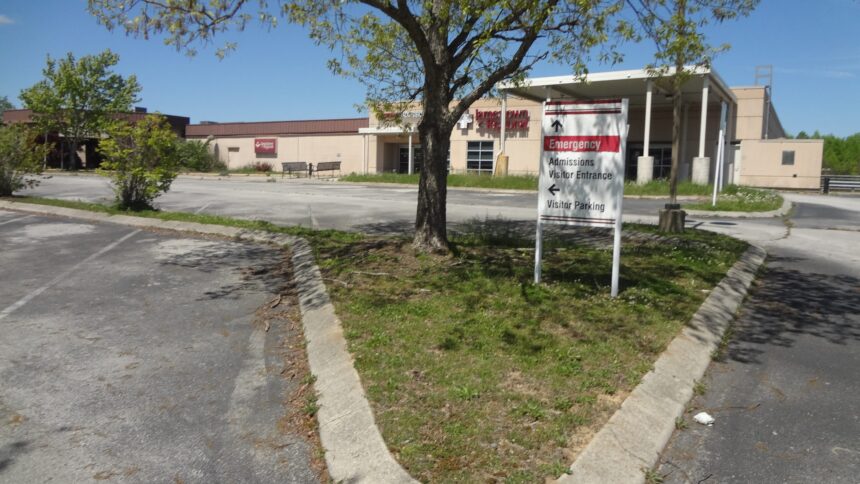JELLICO, Tenn. — In March 2021, this town of about 2,000 residents in the hills of east Tennessee lost its hospital, a 54-bed acute care facility.
Campbell County, where Jellico is located, ranks 90th of Tennessee’s 95 counties in health outcomes and has a poverty rate almost double the national average, so losing its health care cornerstone sent ripple effects through the region.
“Oh, my word,” said Tawnya Brock, a health care quality manager and a Jellico resident. “That hospital was not only the health care lifeline to this community. Economically and socially, it was the center of the community.”
Since 2010, 149 rural hospitals in the United States have either closed or stopped providing in-patient care, according to the Cecil G. Sheps Center for Health Services Research at the University of North Carolina. Tennessee has recorded the second-most closures of any state, with 15, and the most closures per capita. Texas has the highest number of rural hospital closures, with 25.
Each time a hospital closes there are health care and economic ripples across a community. When Jellico Medical Center closed, some 300 jobs went with it. Restaurants and other small businesses in Jellico also have gone under, said Brock, who is a member of the Rural Health Association of Tennessee’s legislative committee. And the town must contend with the empty husk of a hospital.
Dozens of small communities are grappling with what to do with hospitals that have closed. Sheps Center researchers have found that while a closure negatively affects the local economy, those effects can be softened if the building is converted to another type of health care facility.

In Jellico, the town owns the building that housed the medical center, and Mayor Sandy Terry said it is in decent condition. But the last operator, Indiana-based Boa Vida Healthcare, holds the license to operate a medical facility there and has yet to announce its plans for the building, leaving Jellico in limbo. Terry said local officials are talking with health care providers that have expressed interest in reopening the hospital. That’s their preferred option. Jellico does not have a Plan B.
“We’re just in hopes that maybe someone will take it over,” Terry said. Meanwhile, the nearest emergency rooms are a half-hour drive away in LaFollette, Tennessee, and across the state line in Corbin, Kentucky.
An hour and a half away in Fentress County, the building that once housed Jamestown Regional Medical Center has been empty since June 2019, when Florida-based Rennova Health — which also previously operated Jellico Medical Center — locked it up.
County Executive Jimmy Johnson said Rennova’s exit from Jamestown was so abrupt that “the beds were all made up perfectly” and IV stands and wheelchairs sat in the halls. About 150 jobs evaporated when the center closed.
Rennova still owed Fentress County $207,000 in taxes, Johnson said, and in April the property was put up for auction. A local business owner purchased it for $220,000. But Rennova was granted a year to reacquire the building for what it owed in back taxes, plus interest, and did so within a few days.

Abandoned hospital buildings dot the map in central and east Tennessee. But in the western part of the state, two communities found uses for their empty buildings, albeit not in reopening hospitals.
Somerville, about an hour east of Memphis, lost its hospital, Methodist Fayette, in 2015. Methodist Healthcare System, a partnership of Texas-based Methodist Healthcare Ministries and HCA Healthcare, donated the building to the town and threw in $250,000. The building is now a satellite campus for the University of Tennessee-Martin.
The conversion was pushed along by the town leveraging other funding. Bob Turner, Somerville’s city administrator, said both the town and the county matched Methodist’s quarter-million dollars toward the renovation. In its first year in Somerville, the university raised another $125,000. Tennessee’s governor then matched that $875,000 in his state budget.
Somerville is now in the seventh year of a 10-year agreement with the university, which rents the building from the town.
“We have a building, an asset, that’s probably worth $15 million,” Turner said. “It’s a four-year university right here in the heart of Fayette County.”
Mendi Donnelly, Somerville’s community development director, said the county is still in desperate need of a hospital, but “we’re thrilled that we were able to make lemonade out of our lemons.”
Ninety miles to the northeast, in rural Carroll County, Tennessee, another shuttered hospital found new life.
The closing of McKenzie Regional Hospital in 2018 was a blow to the local economy. But Baptist Memorial Health Care, which operates a hospital in nearby Huntingdon, bought the assets — including the building, land, equipment, and ambulance service — and subsequently donated the building to the town of McKenzie.

Cachengo, a technology company, ultimately took over the space. Because of hospitals’ electrical infrastructure, the site was a perfect fit for a business like his, said Ash Young, Cachengo’s chief executive. Young said Cachengo is now looking into repurposing abandoned hospitals across the country.
Jill Holland, McKenzie’s former mayor and a local-government and special-projects coordinator for the Southwest Tennessee Development District, believes the town can become a technology hub.
“It’s opening a lot of doors of opportunity for the youth in the community,” Holland said.
Back in Jamestown, the vacant hospital is “deteriorating,” said Johnson, the county executive. “It could have been used to save lives.” Rennova did not respond to a request for comment.
The University of Tennessee Medical Center opened a freestanding emergency room elsewhere in Jamestown, sparing residents a half-hour drive to the closest ER. Johnson believes the old hospital building could serve the community as housing for those who are homeless or as a facility to treat substance use disorder.
Brock, the health care quality manager, thinks things will get better in Jellico, but the community has had its hopes dashed more than once.
Brock believes a freestanding emergency room could be a viable solution. She urges her community to be responsive to “a new day” in rural health in America, one in which a hospital must focus on its community’s most urgent needs and be realistic about what that hospital can provide.
“Maybe it is just the emergency room, a sustainable emergency room, where you could hold patients for a period of time and then transfer them,” Brock said. “And then you build upon that.”
She added, “There are options out there.”
KFF Health News is a national newsroom that produces in-depth journalism about health issues and is one of the core operating programs atKFF — an independent source for health policy research, polling, and journalism.











